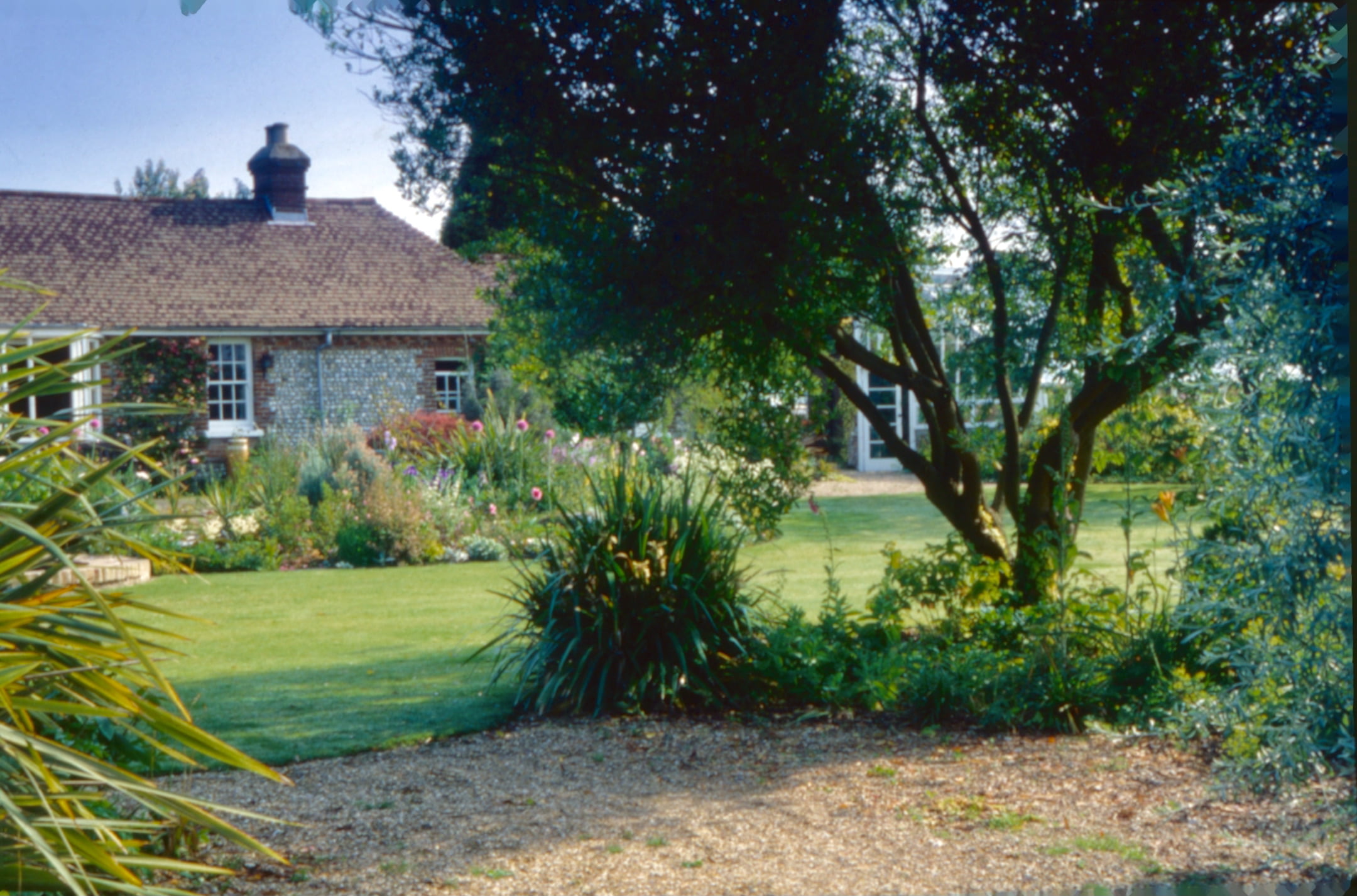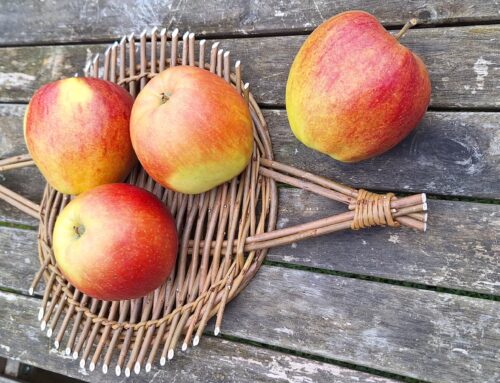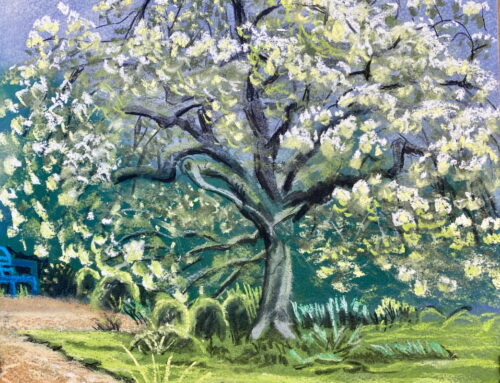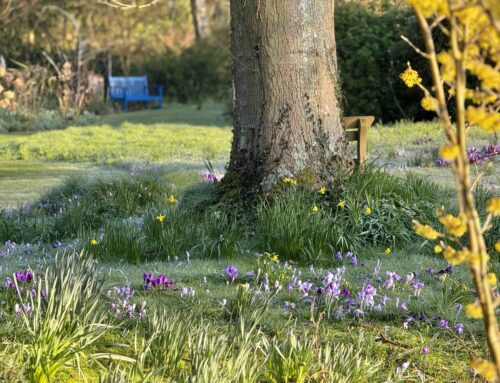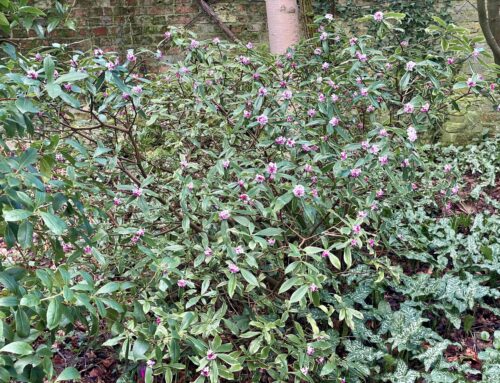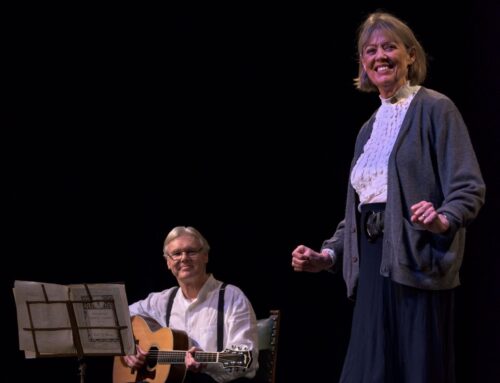An undated photos of the Cottage Gravel Garden.
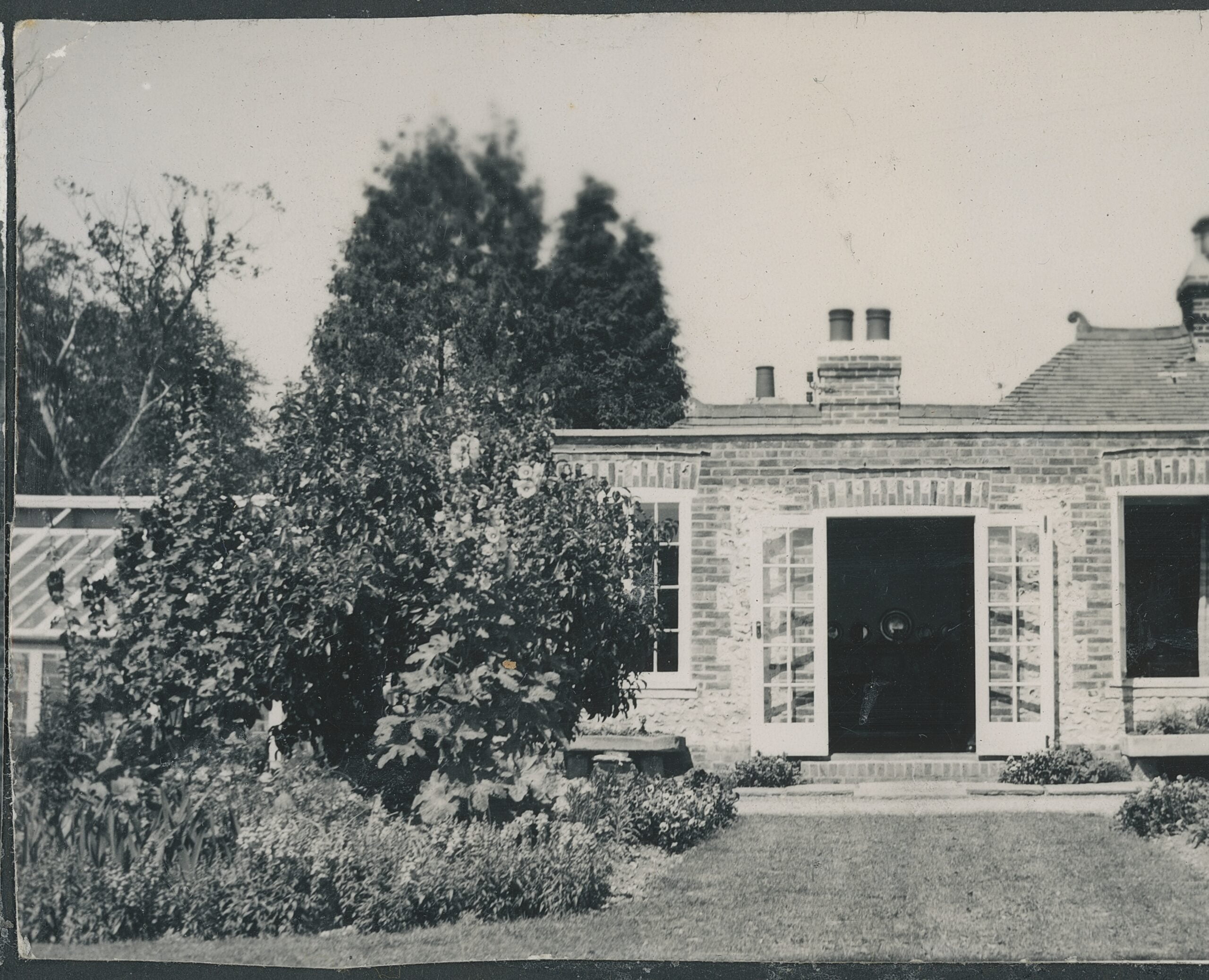
The Cottage Garden, c.1950s. The Conservatory on the left was probably built by Lord Denman.
For the last couple of years, we have been working on a project to restore the gravel garden in front of Mrs. Robinson’s cottage. It was a garden Mrs. Robinson started in the late 1940s and over time grew bigger and bigger.
In the early 1970s, Mrs. Robinson set about converting it into a gravel garden, having been experimenting with gravel as a growing medium in the Walled Garden since 1970. Her inspiration had originally come from a cruise through the Greek Islands where during a stop on the island of Delos she was captivated by the way plants grew naturally and exuberantly in the island’s gravelly soil.
Based on a variety of sources, we believe she started by removing some of the established plants in front of the Cottage; leaving others; and spreading gravel among what remained. No doubt she added new plants in the process and continued to tweak her creation – as gardeners do.
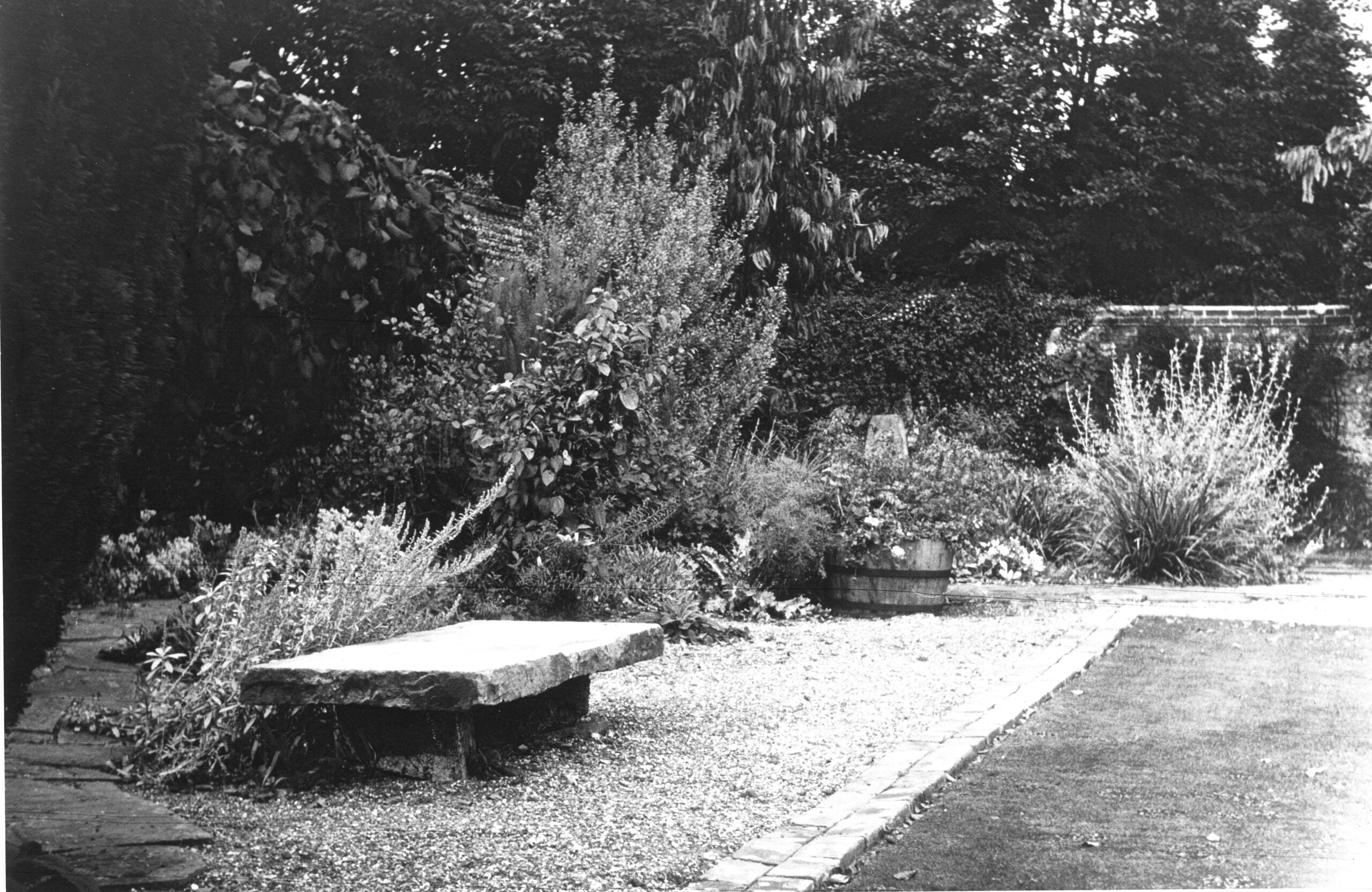
The gravel walks and gardens around the cottage swept around the Main Lawn and included Yorkstone paving and brick. Photo undated.
This gravel area, both in the form of walks and garden, eventually swept from the Cottage to the east of the Conservatory, around the main lawn to the south, and back up to the west side of the Cottage and northward to the gate. Combined in places with brick and Yorkstone paving, the gravel incorporated islands of plantings as well as lawn and this circuit permitted her to walk ‘dry shod’ around her garden, even on wet days.
In 1979 Mrs. Robinson had a bow-front conservatory added to the south side of the Cottage so she could sit comfortably indoors and enjoy the scene she was creating.
Following that in 1982, John Brookes, who had moved to Clock House two years earlier, designed a circular pool of water in front of the Cottage, probably referencing the bow-front shape of the new conservatory. He revised the lines of Mrs Robinson’s existing gravel garden to embrace the new pool with his iconic bold curves.
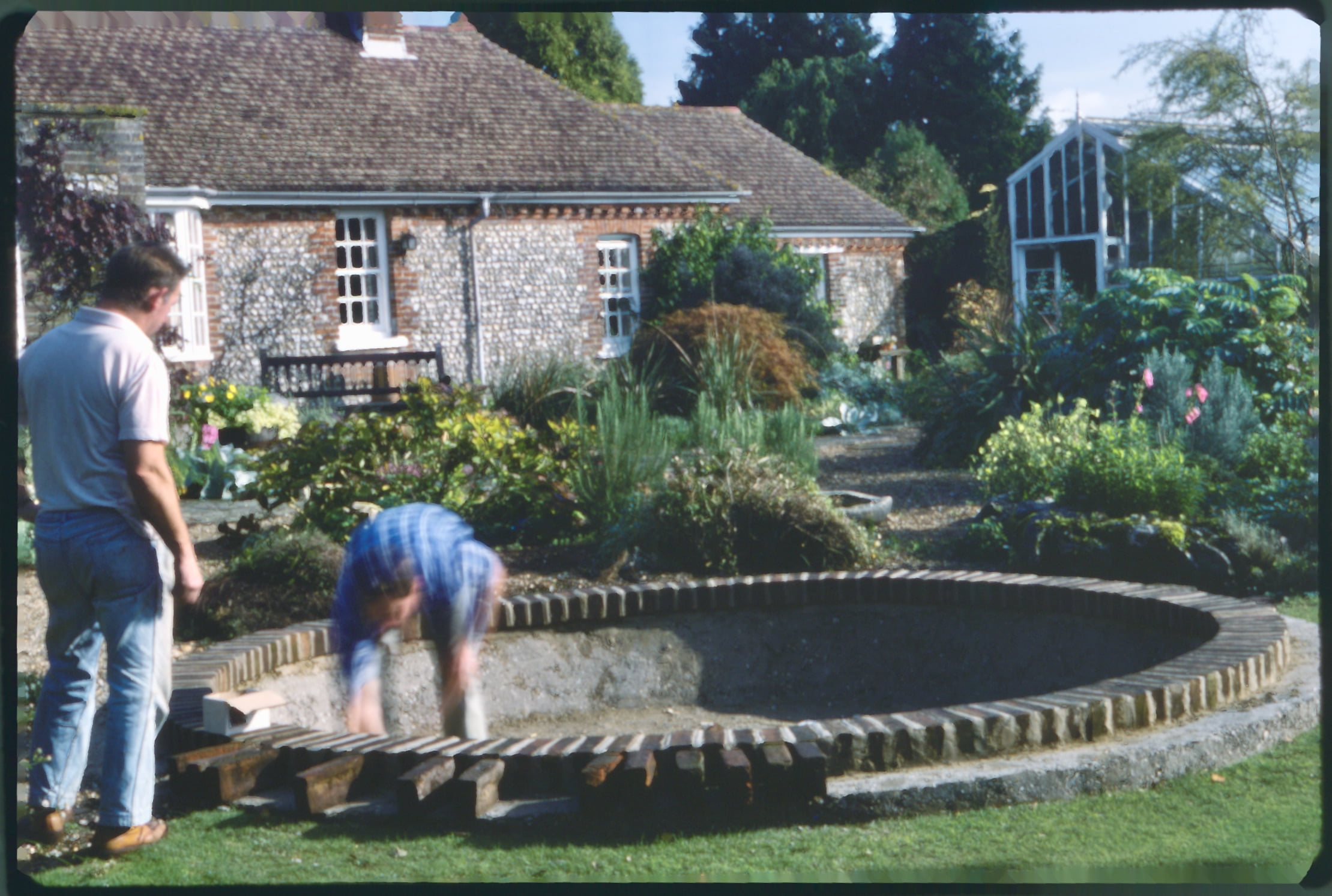
The Circle Pond nearing completion in 1982. The Conservatory to the right was built by Lord Denman.
A photograph we have recently acquired shows the new pond in the last phases of construction. Mrs Robinson’s plantings and the gravel in which they grew are also visible, and from photographs taken a year later, it seems they were largely retained and amplified.
After Mrs. JH died in 1996, John and his business partner bought the property from her family and the business partner moved into the Cottage. By the time we took over, the plantings to the south were so overgrown that the Cottage was only partially visible.
Following the departure of his business partner in the summer of 2017, John decided to move from Clock House to the Cottage – the stairs in Clock House were getting to be too much for his creaky old knees.
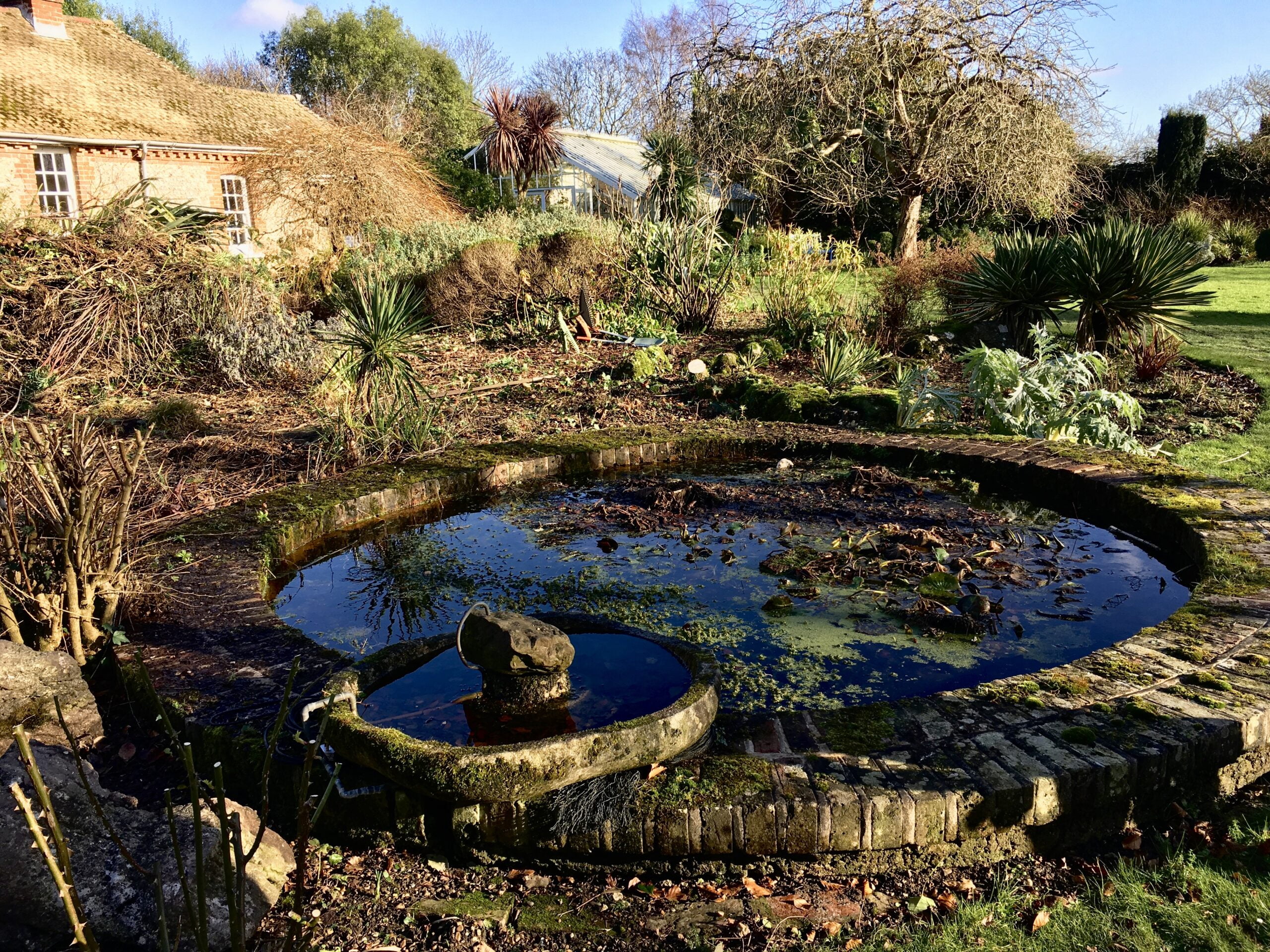
in 2018 John Brookes removed much of the plant material in front of the Cottage.
In January and February of 2018, John oversaw the removal of most of the plants growing in the Cottage Gravel Garden. We had to have a man on a machine – John’s good friend and RHS judge, Steve Smith — for 3 weeks; not just to dig out the overgrown plants and their roots but also to remove what seemed like a few tons of ground elder and other weeds. He also removed the river rocks that Mrs. JH had placed decades earlier.
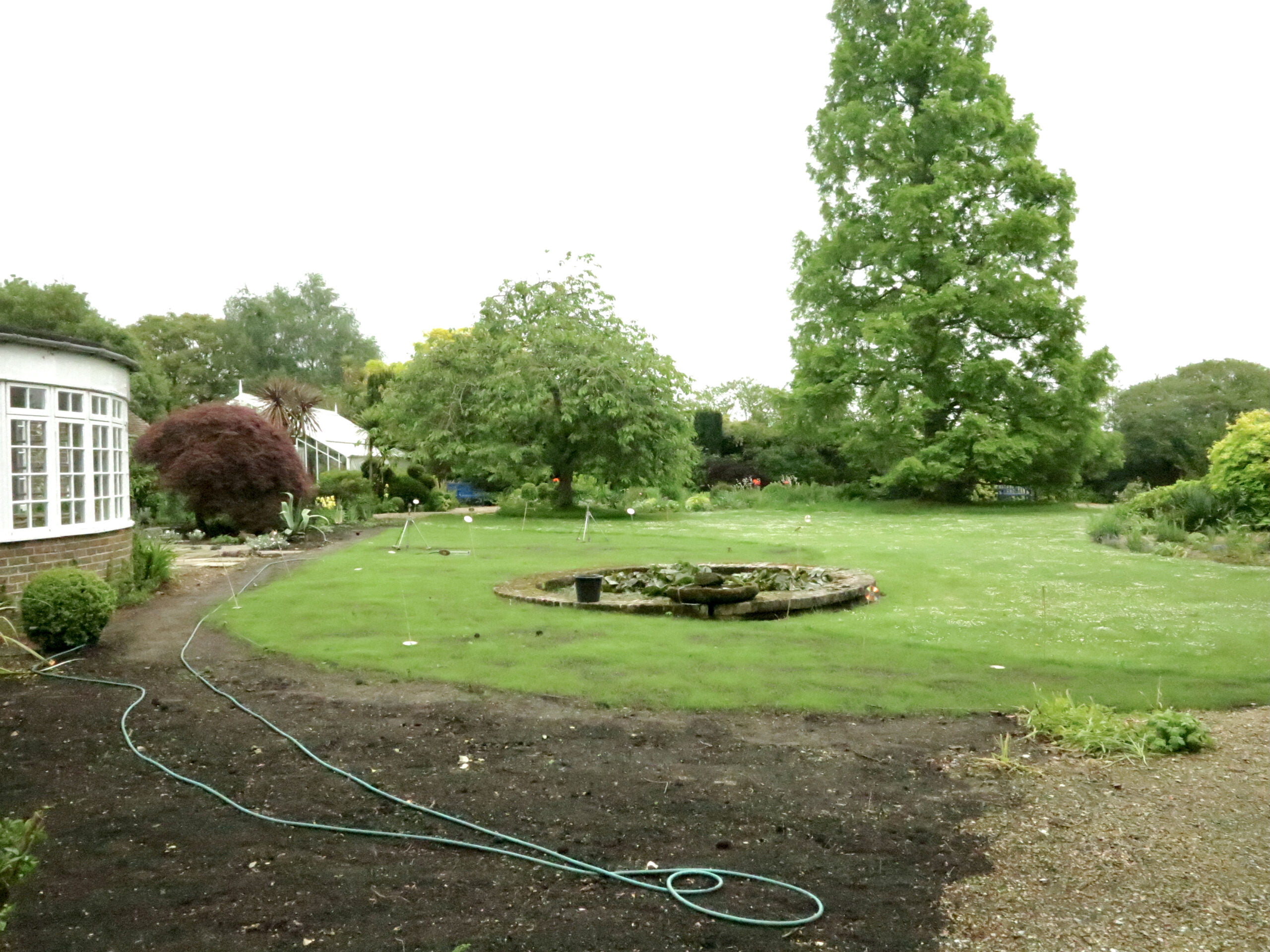
The revised shape of the old Cottage Gravel Garden in June 2018.
Then he revised the layout of the gravel garden area, reducing it and bringing the lawn between the Cottage and the pool in a long arc.
As perennials, trees, and shrubs were removed on the west side of the Cottage, the foundation of the old Victorian conservatory built in Lord Denman’s day was revealed. Graham Best, our fabulous Head Gardener gradually removed an astonishing amount of debris and nearly two feet of rubbish from this area, revealing the original paving and bricks.
When John died in March 2018 the project was far from finished and we had no indication of what he intended to do next. We were left with what seemed like a gaping hole in the centre of the garden.
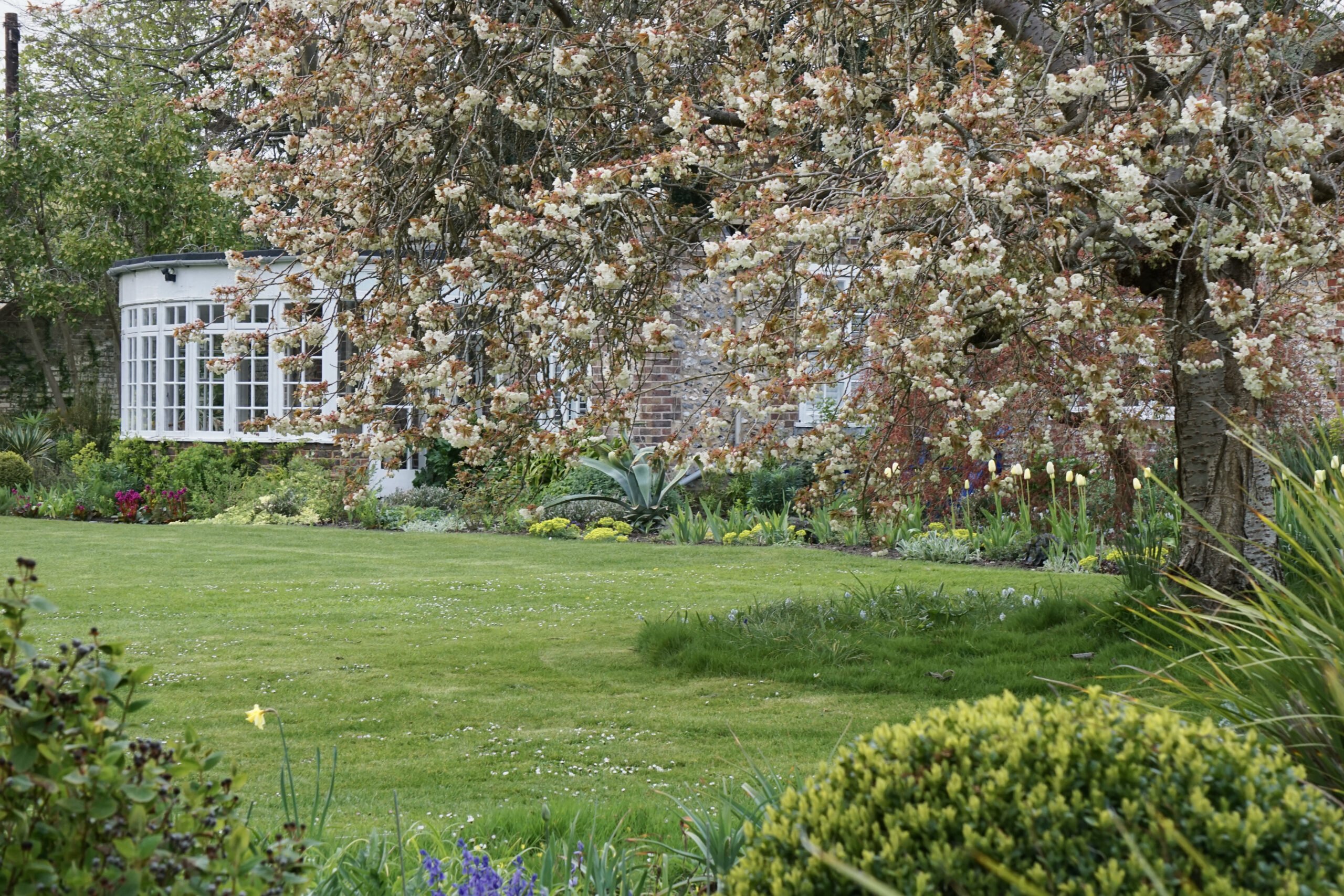
The Cottage Garden in spring of 2019.
We seeded the lawn and planted the border with perennials, roses, and shrubs but not before driving metal spikes along the old edge of the original border in the event we decided to restore it.
Since taking over the garden just over four years ago, our guiding principle has been to do nothing irreversible. The plantings that we installed were easily removed, having served as place holders until we decided what to do. Ultimately, however, although our planting was pretty enough, what we really wanted was to restore the gravel garden.
But what did that mean? We had the outline of the garden but what would we use to guide our plant selection? And the placement of those plants?
Over the past four years, we have been generously given a variety of historical photographs and other material; much of it from Mrs. Robinson’s family, that have helped us understand the evolution of this space.
Among this material is a thesis that was written about Denmans in 1983 by Mary Penniman, and that includes an actual plant list of everything that was in the garden, a year after John built the circular pond and revised the beds.
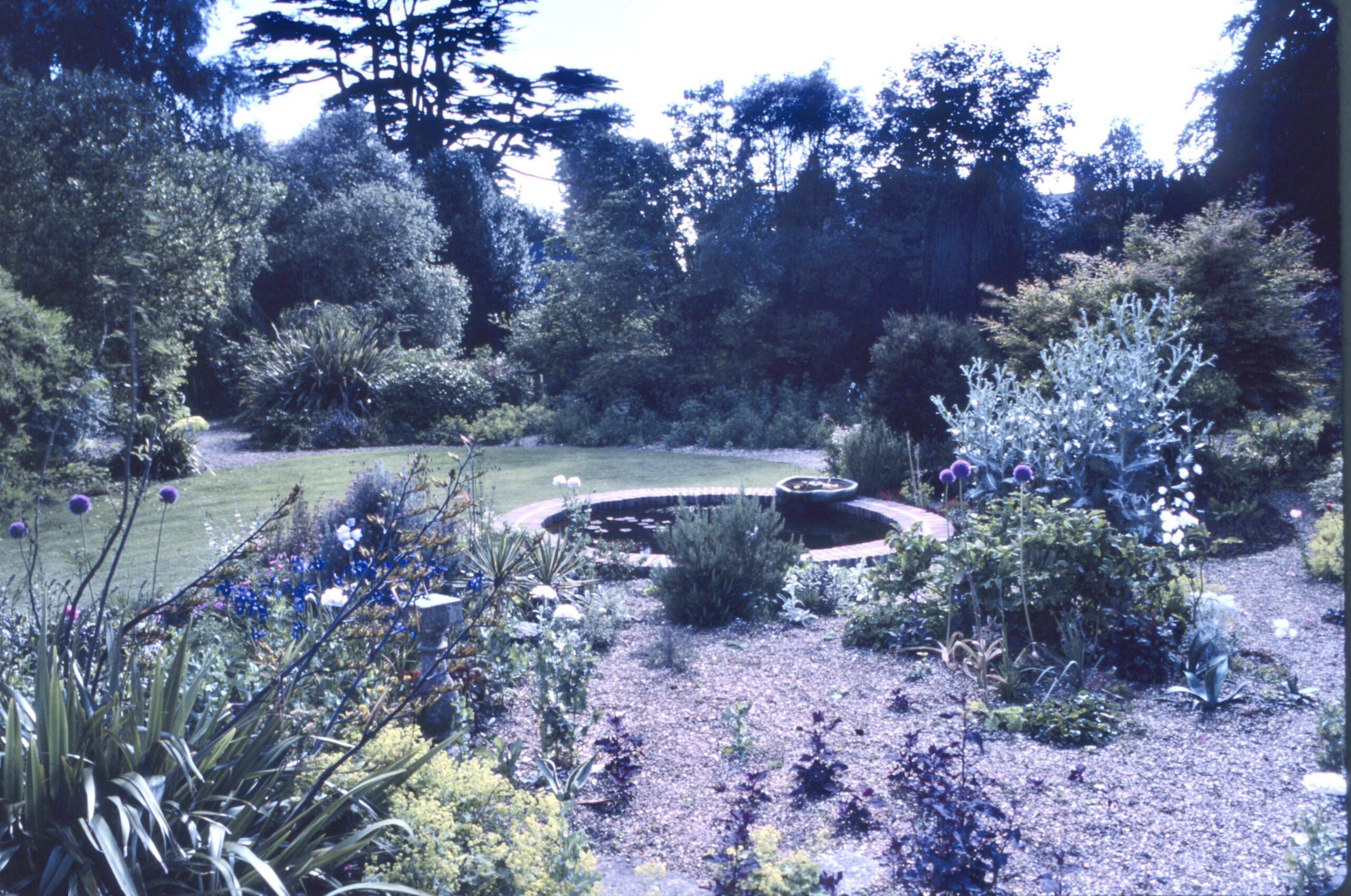
The Circle Pond in 1983, a year after being built.
Therefore, we will plant the garden with perennials, trees, and shrubs that we can identify from the photos we have been collecting along with the information revealed in the thesis.
The project kicked off in Autumn of 2020 when Graham and his team lifted many of the plants we’d installed, but then came to a grinding halt because of the pandemic.
In 2020 we made the now-bare bed presentable and in June 2021 were able to restore the original lines with the help of our metal spikes and Steve Smith, the same man and machine that had taken it all out in the first place.
Unfortunately, the rocks that John had taken out are now at the top of one of the riverbeds and are impossible to lift and move back without doing significant damage, but we have procured similar mossy river rocks which we will place this month, guided by the photographs. We will also place a staddle stone and sundial – they aren’t the originals but are like those that appear in some of the old photos.
The next step will be to install plants. We will select the plant material based on the 1983 plant list and place it according to what we see in the photographs.
We have decided that we will work around the plant material that John did not remove in 2018. Not all the remaining plants appear on the original list, most notably a white wisteria. We know from conversations with family that Mrs Robinson didn’t plant white wisteria, but John loved it.
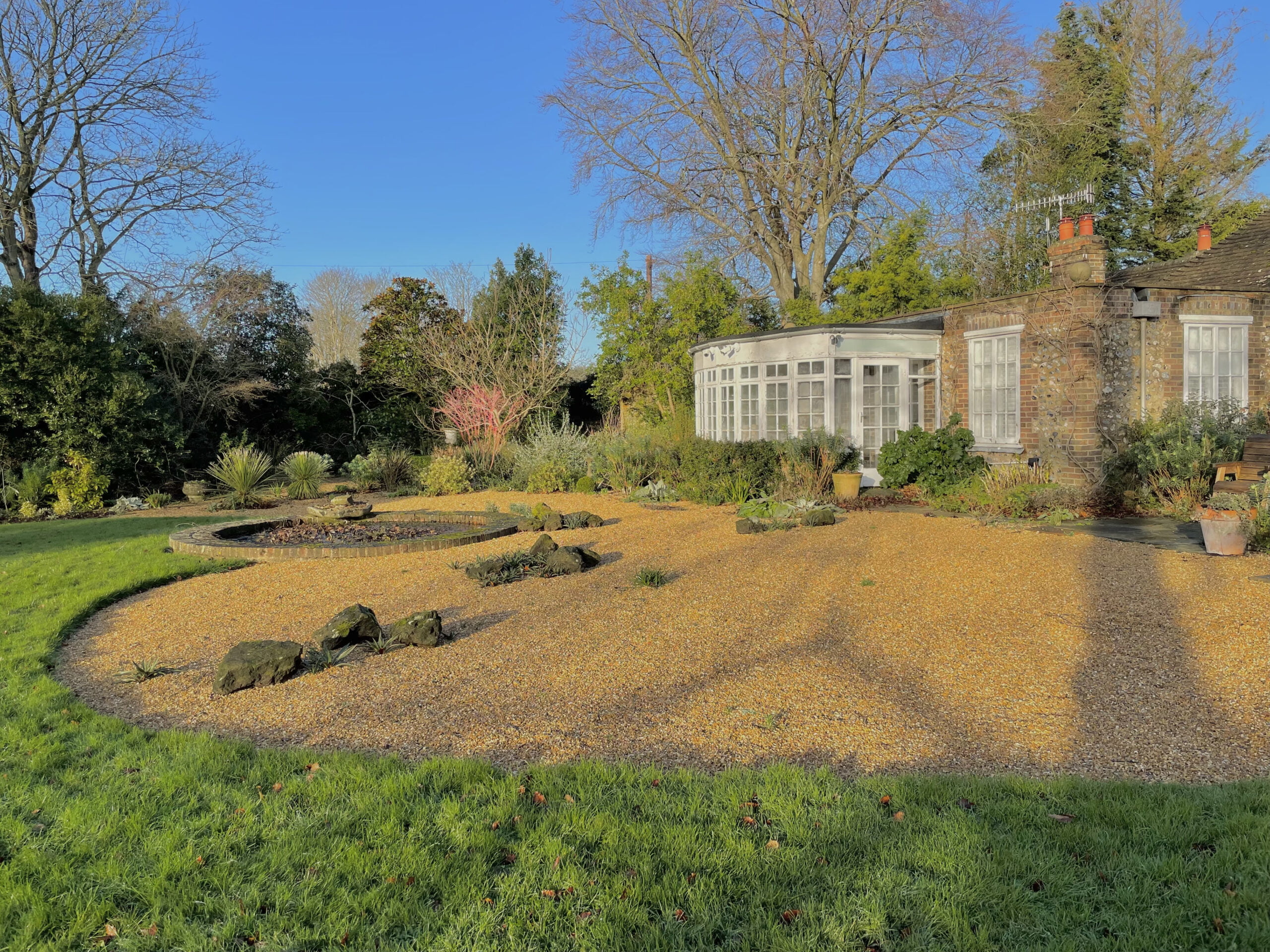
Watch this space!
We will also consider climate change and biodiversity as we make our final plant selections as we believe and understand John and Mrs. JH would have done.
In autumn, we will install perennials and bulbs, again using the reference material as a guide, and continue to tweak what we have done thus far – as gardeners do.
Importantly — when this is finished, we will continue to keep the plantings in a manner consistent with how they were maintained while Mrs. JH was alive; a marked contrast from how overgrown and out of control it was just a few years ago.
We can’t wait to get started!

